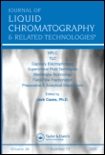
JOURNAL OF LIQUID CHROMATOGRAPHY & RELATED TECHNOLOGIES
Scope & Guideline
Exploring Innovations in Liquid Chromatography
Introduction
Aims and Scopes
- Chromatographic Method Development:
The journal emphasizes the development of new chromatographic methods, particularly high-performance liquid chromatography (HPLC), ultra-performance liquid chromatography (UPLC), and thin-layer chromatography (TLC). These methods are often optimized using statistical approaches such as Box-Behnken design and analytical quality by design (AQbD) principles. - Application in Pharmaceutical Analysis:
A significant focus of the journal is on the application of chromatographic techniques for the analysis of pharmaceuticals, including drug quantification, stability testing, and quality control. This includes bioanalytical methods for therapeutic monitoring and pharmacokinetic studies. - Environmental and Food Safety Analysis:
The journal explores chromatographic applications in environmental science and food safety, including the detection of pesticides, mycotoxins, and other contaminants in food and environmental samples. - Chemometric and Multivariate Analysis:
There is a consistent emphasis on the integration of chemometric techniques to enhance chromatographic analysis. This includes the use of multivariate statistical methods for data interpretation and method optimization. - Emerging Techniques and Technologies:
The journal covers emerging chromatographic technologies and methods, such as the use of ionic liquids, molecularly imprinted polymers, and advanced detection systems like mass spectrometry coupled with chromatography.
Trending and Emerging
- Green Chemistry and Eco-Friendly Methods:
There is a notable increase in research focused on eco-friendly chromatographic methods, including green solvents and sustainable practices. This trend aligns with global initiatives to promote environmental sustainability in analytical chemistry. - Integration of Machine Learning and AI:
Emerging studies are increasingly incorporating machine learning and artificial intelligence techniques to optimize chromatographic processes and analyze complex data sets. This reflects a broader trend in scientific research towards automation and data-driven decision-making. - Focus on Biopharmaceuticals and Complex Mixtures:
Recent publications show a growing interest in the analysis of biopharmaceuticals and complex mixtures, with an emphasis on method development for biologics and therapeutic monitoring. This trend is critical as the pharmaceutical industry shifts towards more complex formulations. - Advanced Detection Techniques:
The integration of advanced detection techniques, such as mass spectrometry and fluorescence detection, with liquid chromatography is on the rise. This trend enhances the sensitivity and specificity of analytical methods, making them more applicable to a variety of fields. - Chemometric Applications in Quality Control:
There is an emerging trend in applying chemometric methods for quality control in various industries, particularly in pharmaceuticals and food safety, to ensure compliance with regulatory standards and improve product quality.
Declining or Waning
- Traditional Methods Without Enhancement:
There has been a decline in publications focused solely on traditional chromatographic methods without significant innovation or enhancement. The trend is moving towards methods that incorporate advanced technologies or optimization techniques. - Basic Separation Techniques:
Publications focusing on basic separation techniques that do not integrate chemometric or multivariate analysis have decreased. The emphasis is now on studies that combine traditional methods with modern analytical strategies. - Isolated Studies on Natural Products:
While natural products remain a vital area of research, there seems to be a waning interest in isolated studies that do not incorporate advanced analytical techniques or comprehensive quality assessments. The trend is shifting towards holistic approaches that consider multiple compounds and their interactions.
Similar Journals

LCGC EUROPE
Advancing chromatographic science for a brighter tomorrow.LCGC EUROPE is a prominent journal dedicated to the field of analytical chemistry, specifically highlighting the latest trends and innovations in chromatographic techniques. Published by MJH Life Sciences, this journal has served as a valuable resource for researchers, professionals, and students interested in the nuances of laboratory practices and the advancement of instrumentation. Although LCGC EUROPE ceased its coverage in Scopus from 2018, it has maintained a significant influence within the community, evidenced by its Scopus rank of 90/114 in Analytical Chemistry, placing it in the 21st percentile. With its inception dating back to 1996, the journal provided essential insights and peer-reviewed articles, fostering a rich understanding of chromatographic science. While the journal is not currently open access, it remains an integral part of the literature for anyone engaged in the analytical chemistry landscape, especially as it pertains to laboratory methodologies and innovations.
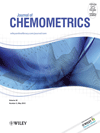
JOURNAL OF CHEMOMETRICS
Bridging Chemistry and Mathematics for Enhanced UnderstandingJOURNAL OF CHEMOMETRICS is a prestigious journal published by Wiley that has been a cornerstone in the fields of analytical chemistry and applied mathematics since its inception in 1992. With an ISSN of 0886-9383 and an E-ISSN of 1099-128X, this journal occupies a notable position, reflected in its Scopus rankings where it holds the 90th rank in Applied Mathematics and the 56th rank in Analytical Chemistry. The journal, based in the United Kingdom, spans a converged publication timeline through 2024, meticulously exploring the interplay between chemical data analysis and mathematical methodologies. Though currently not open access, it offers essential insights through high-quality research articles that significantly contribute to advancing the understanding of chemometric techniques and their applications. With an impact factor demonstrating robust academic recognition, the JOURNAL OF CHEMOMETRICS serves as an invaluable resource for researchers, professionals, and students aiming to excel in the ever-evolving landscape of chemical data interpretation.

ANALYTICAL AND BIOANALYTICAL CHEMISTRY
Illuminating the Path of Chemical InnovationANALYTICAL AND BIOANALYTICAL CHEMISTRY, published by SPRINGER HEIDELBERG, is a leading international journal that serves as a vital platform for innovative research in the fields of analytical and bioanalytical chemistry. With an impressive impact factor and ranking in the Q2 category for both Analytical Chemistry and Biochemistry, the journal highlights key advancements and methodologies that drive the discipline forward. Established in 1996 and continuing vigorously into 2024, it has gained significant recognition with Scopus rankings placing it in the 83rd and 78th percentiles within its categories, underscoring its impact and relevance. The journal's commitment to open access facilitates widespread dissemination of critical scientific knowledge, making it an essential resource for researchers, professionals, and students dedicated to exploring the complexities of chemical analysis. With its base in Heidelberg, Germany, ANALYTICAL AND BIOANALYTICAL CHEMISTRY continues to inspire and influence the global research community.

ACTA CHROMATOGRAPHICA
Connecting Researchers through Chromatographic ExcellenceACTA CHROMATOGRAPHICA is a distinguished academic journal dedicated to the field of chromatography and its applications, published by AKADEMIAI KIADO ZRT. With a history spanning from 1996 to 2024, this journal serves as a vital platform for the dissemination of innovative research and advancements within the field, contributing significantly to the body of knowledge in the domain of general chemistry. Operating out of Budapest, Hungary, ACTA CHROMATOGRAPHICA holds a Q3 ranking in the chemistry category as of 2023, reflecting its impact and relevance among its peers, achieving a Scopus ranking of 180 out of 408 in the General Chemistry category, placing it in the 56th percentile. While not currently Open Access, the journal offers robust subscription options for readers and institutions seeking to stay informed on the latest developments in chromatography. FACTA CHROMATOGRAPHICA aims to foster communication, collaboration, and discovery, making it an essential resource for researchers, professionals, and students seeking to enhance their expertise in this evolving field.
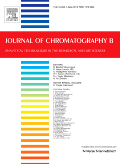
JOURNAL OF CHROMATOGRAPHY B-ANALYTICAL TECHNOLOGIES IN THE BIOMEDICAL AND LIFE SCIENCES
Empowering Scholars with Cutting-edge Analytical InsightsJOURNAL OF CHROMATOGRAPHY B-ANALYTICAL TECHNOLOGIES IN THE BIOMEDICAL AND LIFE SCIENCES, published by Elsevier, stands as a critical resource in the fields of analytical chemistry, biochemistry, and life sciences. With an impressive convergence of research spanning from 2002 to 2024, this journal delivers high-quality, peer-reviewed articles that advance the methodologies and practices related to chromatographic techniques and their applications in biomedical research. The journal enjoys a reputable standing in the academic community, reflected in its 2023 Scopus rankings—ranked in the 65th and 55th percentiles in Analytical Chemistry and Clinical Biochemistry, respectively. Although it does not offer open access, it provides a vital platform for exchanging innovative ideas and findings, guiding professionals and scholars in addressing the complexities of contemporary biomedical challenges. The journal’s focus on interdisciplinary research positions it as an essential tool for researchers, professionals, and students eager to enhance their knowledge and contribute to advancements in this dynamic field.

CHROMATOGRAPHIA
Pioneering Discoveries in Chemistry and BiochemistryCHROMATOGRAPHIA is a renowned scholarly journal published by Springer Heidelberg, specializing in the field of analytical chemistry, biochemistry, and organic chemistry since its inception in 1968. With its ISSN 0009-5893 and E-ISSN 1612-1112, the journal has maintained a robust profile, currently ranking in the Q3 and Q4 quartiles within significant Chemistry categories. Aimed at researchers, professionals, and students, CHROMATOGRAPHIA serves as a critical platform for disseminating innovative research, methodologies, and advancements related to chromatography and its applications in various scientific fields. While the journal is not open access, it offers significant visibility and scholarly contribution opportunities, making it an essential resource for those engaged in the vibrant intersection of chemistry and biochemistry.
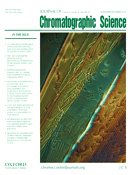
JOURNAL OF CHROMATOGRAPHIC SCIENCE
Pioneering Insights in Analytical Chemistry and MedicineWelcome to the Journal of Chromatographic Science, a premier publication dedicated to advancing the scientific understanding of chromatographic techniques and their applications across various disciplines. Published by Oxford University Press Inc, this journal, with its ISSN 0021-9665 and E-ISSN 1945-239X, has been disseminating innovative research since 1963, serving as a vital resource for researchers, industry professionals, and academic scholars in the fields of Analytical Chemistry and Medicine. As evidenced by its 2023 Scopus ranking, the journal stands at the Q3 quartile in both its primary disciplines, highlighting its relevance and contribution to ongoing research. The journal promotes high-quality, peer-reviewed articles that aim to foster knowledge and encourage the practical application of chromatographic science. While it operates under a traditional subscription model, the valuable insights it offers are essential for those seeking to enhance their expertise and stay at the forefront of chromatographic methodologies. Join our community of scholars as we explore the complexities and innovations in chromatographic science, paving the way for future discoveries.

Analytical Science and Technology
Fostering collaboration and knowledge in diverse scientific fields.Analytical Science and Technology is a prominent journal dedicated to advancing the fields of analytical chemistry and technology, published by the Korean Society for Analytical Science. Based in South Korea, this journal serves as a vital platform for researchers, professionals, and students committed to exploring innovative analytical techniques and methodologies. Although it is classified under Q4 in various subject categories, including Agronomy and Crop Science, Environmental Chemistry, and Pharmacology, the journal aims to provide critical insights and contributions to the scientific community. With ISSN 1225-0163 and E-ISSN 2288-8985, it spans a converged timeline from 2019 to 2024. Despite its current standings in Scopus rankings, the journal is dedicated to improving its visibility and impact through rigorous peer review and high-quality publications, fostering knowledge sharing within its diverse academic fields. Researchers looking for a reliable outlet for their findings are encouraged to consider this journal as it continues to strive for excellence in analytical science.
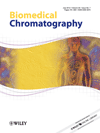
BIOMEDICAL CHROMATOGRAPHY
Transforming Analytical Chemistry for Better HealthBiomedical Chromatography is a prestigious journal published by Wiley, focusing on the vital intersections of analytical chemistry, biochemistry, and clinical studies. With an ISSN of 0269-3879 and E-ISSN of 1099-0801, it has served the research community since its inception in 1986. The journal provides a platform for innovative research in areas such as drug discovery and pharmacology, achieving a commendable placement in Q3 across multiple categories in the 2023 metrics, including Analytical Chemistry and Biochemistry. Although it currently does not offer open access, it plays a crucial role in disseminating scientific developments and methodologies that contribute to advancements in health, safety, and pharmaceuticals. Researchers, professionals, and students can anticipate high-quality, peer-reviewed articles that drive forward the collective knowledge in biomedical applications. Located in the United Kingdom at 111 River St, Hoboken, NJ, the journal continues to attract contributions from global thought leaders in the field.

Food Analytical Methods
Pioneering research for a safer and healthier food supply.Food Analytical Methods, published by Springer, is an esteemed journal dedicated to the innovative field of analytical methodologies within the food sciences. With an ISSN of 1936-9751 and E-ISSN of 1936-976X, this journal serves as a pivotal platform for researchers and professionals to exchange insights, methodologies, and findings related to food quality analysis, safety measures, and innovative technologies in food science. As of 2023, Food Analytical Methods boasts impressive Scopus rankings, including Q2 in Analytical Chemistry and Food Science, positioning it among the top journals in its category. The journal's commitment to enhancing food safety and quality through rigorous research underscores its importance in both academic and industrial applications. Although it does not currently operate under an open-access model, it provides exceptional value through its rigorous peer-review process and comprehensive publication standards, further inviting contributions from both established and emerging scientists in the field. With coverage spanning from 2008 to 2024, this journal continues to address critical research areas, thereby shaping the future of food analytics.